Stream ID
Minnesota Department of Natural Resources (MNDNR) stream ID M-055-020
Minnesota Pollution Control Agency (MPCA) stream ID S002-548. This link provides available information on stream quality. This sampling site had the most complete, ongoing data collection on Chaska Creek; other sampling sites are identified in the adjacent table.

Chaska Creek, also known as West Chaska Creek, is a seven-mile (11-kilometer) stream located in Carver County that drains 15.6 sq. miles (4,030 hectares) (CCWMO, 2022). The stream is confined to a concrete channel around the west side of Chaska, Minnesota, and empties onto the Minnesota River floodplain after passing through a man-made flood-control levee. Current land use is 64% agricultural followed by 29% percent natural, wetland, and open water and 7% percent developed (CCWMO, 2022). Chaska Creek is impaired for aquatic life because of benthic macroinvertebrate and fish bioassessments and aquatic recreation because of fecal coliform (MPCA, 2022). Only the most downstream portion of Chaska Creek, in the City of Chaska and on the Minnesota River floodplain, is within the Lower Minnesota River Watershed District (LMRWD).
The LMRWD funds routine sampling of the creek by the Carver County Watershed Management Organization (CCWMO). Selected results from an analysis of the samples collected from Chaska Creek are summarized in the following graphs. The data were obtained from the MPCA website linked above. Samples were not collected during the winter months.
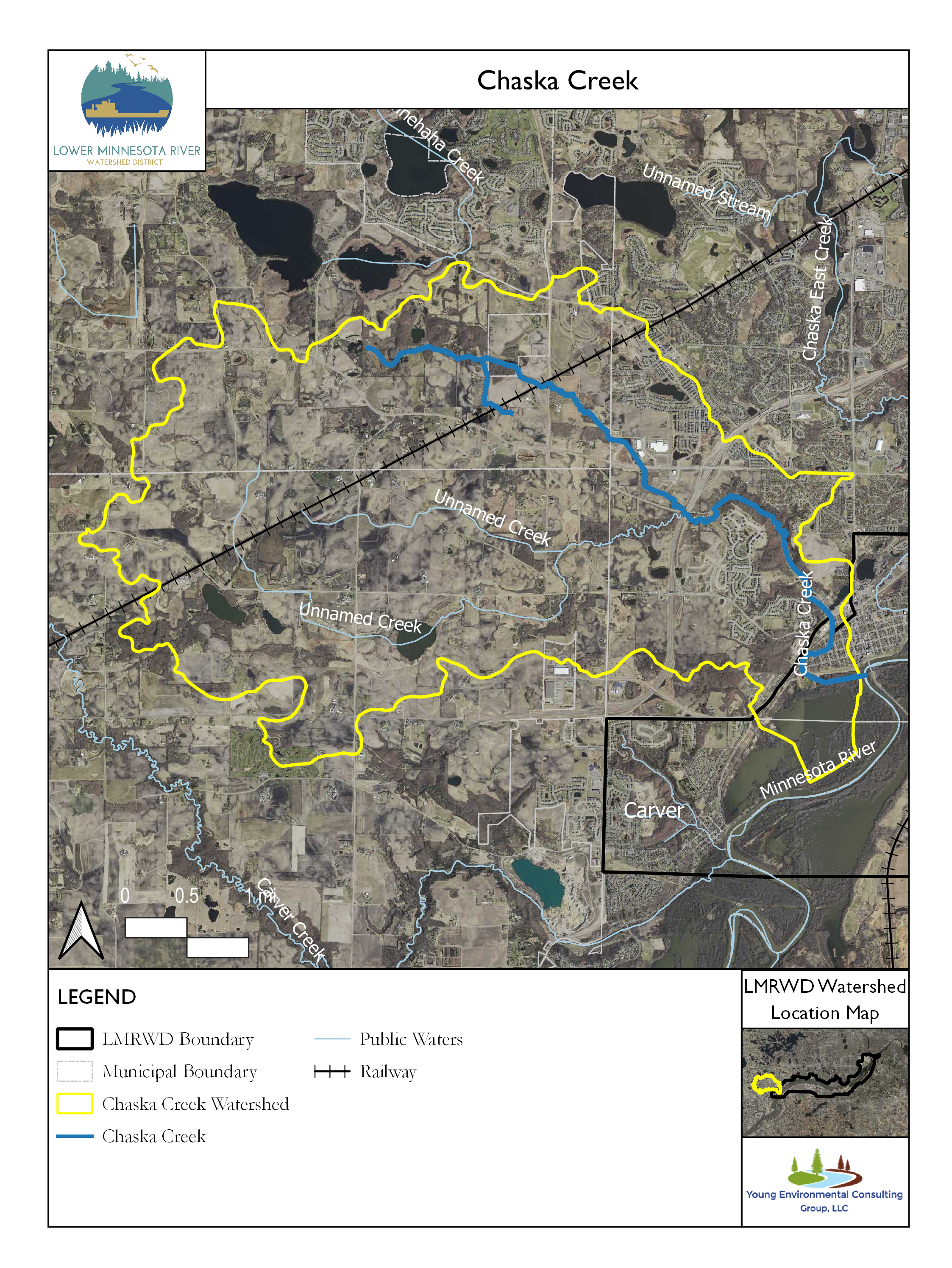
Monitoring Data
Water Temperature
The water temperature of Chaska Creek is important because warmer water holds less of the dissolved oxygen needed by aquatic organisms. Temperatures at the sampling sites fluctuate seasonally, occasionally exceeding 68° Fahrenheit (20° Celsius) in the summer. Although not part of the sampling program, it is expected that water temperatures are close to 32°F (0°C ) in the winter.
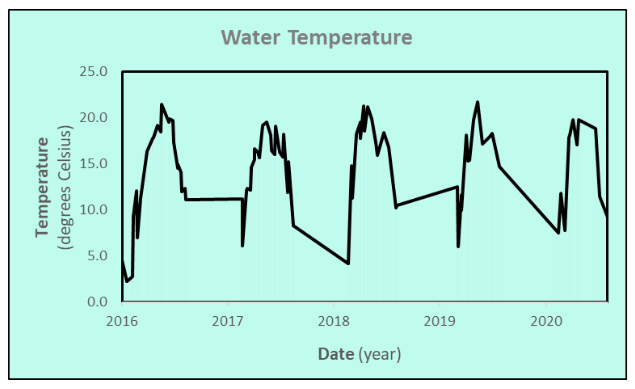
Dissolved Oxygen
Dissolved oxygen (DO) concentration measurements show that Chaska Creek remains well oxygenated. Many aquatic animals typically need at least 5 milligrams per liter (mg/L) of DO to survive (MNDNR, 2021). Seasonal fluctuations are normal because oxygen’s solubility changes with the water’s temperature. The 21 mg/L measured during March 2016 is higher than the 13.8 mg/L saturation concentration expected at the 36°F (2.2°C) water temperature measured during sample collection.

Transparency
The adjacent graph shows the transparency, a measure of water clarity, of Chaska Creek. Low transparency in a stream indicates cloudy water carrying greater amounts of fine sediment that interferes with visibility. High transparency indicates that less sediment is carried by the stream. Streams receiving runoff tend to be turbid with reduced transparency when they might otherwise run clear. The measurement can be limited by the length of the 100-centimeter tube that is used to measure transparency.
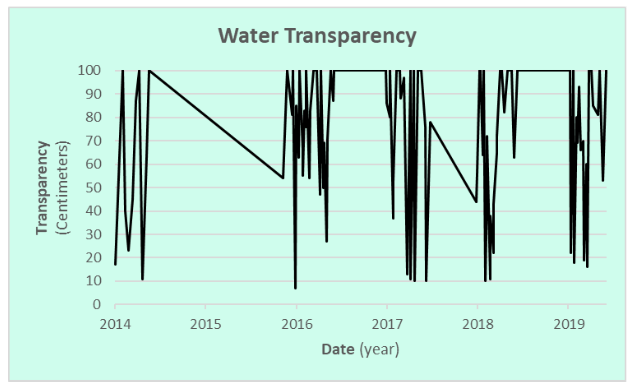
Phosphorus
Phosphorus is an essential plant nutrient that is carried by streams. Naturally occurring phosphorus concentrations may be enriched from animal wastes and fertilizers, and it often is introduced with runoff. The adjacent chart shows the concentrations of phosphorus in unfiltered samples from Chaska Creek.
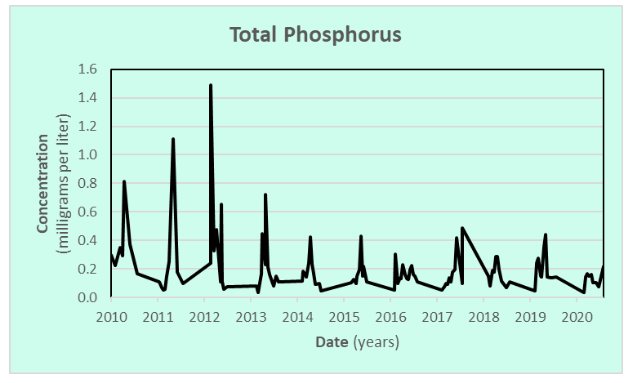
Escherichia coli
Escherichia coli (E. coli) is an organism used to indicate the amount of fecal contamination in lakes and rivers. Swimming or ingesting water with high levels of E. coli could result in illness. Chaska Creek often has levels of E. coli that exceed the allowance for recreational use and human health. The allowable limit is a monthly average of less than 126 colony-forming units per 100 milliliters of water between April and October (MPCA, 2021).
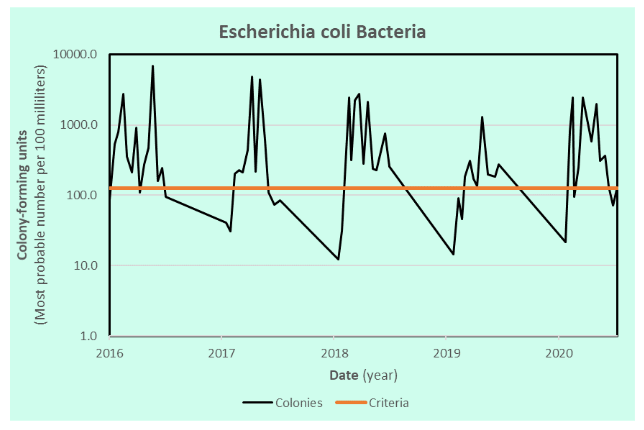
References
CCWMO. (2022, January 26). 2021 Monitoring Report of the East and West Chaska Creek Watersheds. Retrieved from East and West Chaska Creeks: https://storymaps.arcgis.com/stories/c5e97f413677481988a9cadfc285ae87
MNDNR. (2021). Stream basics | Minnesota DNR. Retrieved Nov 3, 2021, from https://www.dnr.state.mn.us/fishing/trout_streams/stream_basics.html
MPCA. (2021). Water quality and bacteria frequently asked questions. St. Paul, MN: Minnesota Pollution Control Agency. Retrieved Jan 27, 2022, from Minnesota Pollution Control Agency: https://www.pca.state.mn.us/sites/default/files/wq-s1-93.pdf
MPCA. (2022). Metropolitan Area Watershed Outlet Monitoring Program. Retrieved Mar 16, 2022, from Minnesota's Legacy: https://www.legacy.mn.gov/projects/metropolitan-area-watershed-outlet-monitoring-program-0
This data was last updated December 2021.